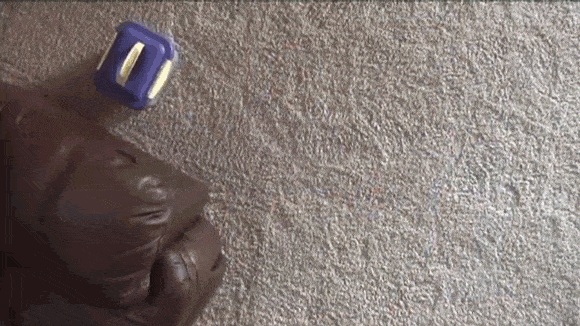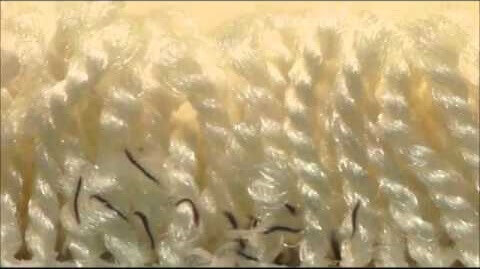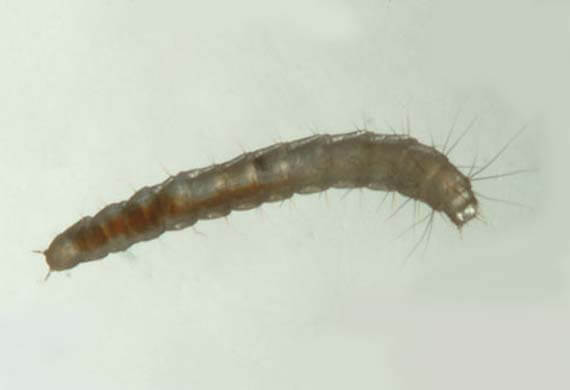Did you know that for every flea that you see on your pet, there is usually another 10x around your home, either in the egg form or as larvae? That is why it’s important to take a holistic approach that covers all areas of your home, garden and pets, and that means treating both the visible fleas, the ones lurking in the shadows and those that have yet to complete their development. After all, flea larvae will turn into adult fleas, which we all hate right?!
In this article, I will discuss some commonly asked questions, such as its appearance and where you might find it and how to get rid of the larvae as soon as possible. Lastly, I will cover a few interesting facts that will help complete your education on this subject.
Can flea larvae get on my bed?
No, it is very unlikely that you will find flea larvae in your bed. Why is that the case? Well, they actually lack the ability to “hold on” to a pet (or a person) during this phase in their life cycle. They simply haven’t developed the sucking mouthparts and the ability to pierce the skin (to drink blood), and instead chew dried fecal blood that is dropped by adult fleas and find other forms of nourishment found in the base of your carpets.
The only exception would be if your pets had fleas and spent a large amount of time on a certain bed, which nobody used (or cleaned) for a number of weeks. In this unlikely scenario, the room itself would also be infested with fleas, which could provide an indirect source of food (often referred to as flea dirt, which is basically dried fecal matter from adult fleas) for the larvae. Lastly, the room would need to be very dark, as larvae tries to escape light at any cost.
As you can hopefully see, it is incredibly unlikely that larvae are living in your bed, and even though it would be a little creepy (literally) if they were, remember that flea larvae don’t bite (unlike adult fleas) or pose any danger to humans or pets. However, please note that although a little off-topic (for this article), adult fleas can live in your bed, so keep that in mind if you get bite marks.
What does flea larvae look like?
Before we start discussing this, please remember that flea larvae are very small and are very very unlikely to exist without you having a flea problem in your home. So while they should be dealt with as soon as possible (more on killing them later), I would recommend you look for live fleas if you are checking for an infestation, not trying to find larvae.
Flea larvae goes through three transformations during its growth into the pupal stage (where it usually spins a cocoon to grow into an adult flea). During each stage, the larvae looks almost the same, so it is not really worth fussing over the minor details of how their appearance differs as they grow.
After they bust out of their warm, cozy egg, the larvae are about 2.5mm long and have a distinct whitish color and light hairs on their worm-like bodies. They don’t have any eyes and instead are highly negatively phototactic, which basically means they hate light and will try to move away from it as fast as possible. Also, despite their tiny size and lack of vision, they can move around fairly well in their continuous and endless search for food.
Is it possible to see them? Well yes, but it can be incredibly difficult due to their size and the fact that they hate light. However, if you are curious about what they look like, check out the image below for easy identification. Unfortunately, I cannot find the original source for it (it was one of those images that I just saved while doing some research), so if you are reading this and it is yours, please let me know. Also, if you have a couple of pictures of flea larvae, please let me know and I will share them here for others to enjoy.
Can this larvae live on cats, dogs or humans?

No, as previously mentioned, they don’t have the ability to suck blood or even the ability to pierce the skin of their intended target. Instead, they have mandibles for chewing solid bits of organic matter, which is usually dried fecal matter left behind by adult fleas.
They wouldn’t even be able to hang on, as they have no way to do so without the correct appendages. All they have is their body and tiny hairs, which are not exactly good for staying on you or your pet.
Keeping this in mind, rest assured that you definitely don’t have little flea larvae running around on yourself or on your furry friend Personally, I think that is quite a relief lol.
How to get rid of flea larvae (Three easy steps)
Before we start, please remember that it is incredibly unlikely that you have flea larvae without adult fleas roaming around your house. I know I have mentioned this already, but I want you to understand that killing the adult fleas and larvae should happen at the same time, not treated separately. It is important to get rid of all stages of fleas if you want to be truly flea free.
If you don’t, you may get some relief for a couple weeks/months, only to suffer again when the next generation of fleas become adults.
 Step 1: After you have treated your pets (a good dawn soap bath and spot on treatment works wonders), get yourself some food grade diatomaceous Earth from your local gardening/outdoor/walmart type of store. If you cannot find it locally, simply pop onto Amazon/etc, there are plenty sellers that sell the non-toxic version (“food grade”).
Step 1: After you have treated your pets (a good dawn soap bath and spot on treatment works wonders), get yourself some food grade diatomaceous Earth from your local gardening/outdoor/walmart type of store. If you cannot find it locally, simply pop onto Amazon/etc, there are plenty sellers that sell the non-toxic version (“food grade”).
Step 2: Take your DE powder and put it into a plastic container (like an icecream box) and punch tiny holes into the lid. Once closed, you can use this to apply the diatomaceous earth (like you would use a salt shaker) by sprinkling a fine layer over your carpets. Once complete, take a regular brush broom and rub it in so it reaches deep down so the larvae (and adult fleas) have nowhere to hide (read more here).
Step 3: After it has been down for a couple days (longer the better, just keep it away from moisture), suck it up using a bag based vacuum. Please do not use any fancy water based/cyclone, etc. systems, as the powder can clog them up and burn out the motor. Ideally, hire yourself a shop vac (if you don’t have one already) for the day and use that, as they are super effective.
That is about it, nice and easy and the good news is that this works for adult fleas as well (as in, it will kill them). It is completely non-toxic and although it is a little messy to apply, it is a very cost effective method. If you are curious about how it works and for a detailed guide on using it for adult fleas, check out this DE article on my blog.
Five interesting facts about larvae from fleas
Fact #1: Larvae is the second phase in the flea life cycle. After they have built themselves a cocoon, develop into pupae and grow, only then do they become the adult fleas. This process can take anything from a couple weeks to months, depending on environmental conditions.
Fact #2: If you want to try to stop the flea life cycle (e.g. eggs hatching into larvae), you can use an insect growth regulator, which is often found in a number of sprays and various flea foggers (check this article out before using them). However, please remember that it has to actually reach the eggs/pupae if it is going to make any difference, and this is why I usually opt for going the DE treatment route.
 Fact #3: If you think you have sorted out a flea infestation, only to have the same problems a couple weeks later, it is very possible that you are not getting rid of the eggs/larvae in your home. This is probably the number 1 issue that I experience with feedback from my readers, and I always have the same answer. You have to deal with all stages of the fleas in your home if you want to win the battle.
Fact #3: If you think you have sorted out a flea infestation, only to have the same problems a couple weeks later, it is very possible that you are not getting rid of the eggs/larvae in your home. This is probably the number 1 issue that I experience with feedback from my readers, and I always have the same answer. You have to deal with all stages of the fleas in your home if you want to win the battle.
Fact #4: People are often confused that they have a flea problem because they don’t have any pets. The reality is that you can get fleas coming into your home (or your garden, which is best treated using beneficial nematodes) from vermin (rats, raccoons, squirrels, etc.). If you treat your home properly and keep getting fleas at the same time each year, consider checking your roof/basement for signs of these animals.
Fact #5: I have had a lot of concern from my readers (in the past) about flea larvae biting them. As mentioned briefly in this article, this is simply not possible. Although they do have mandibles for chewing flea feces (gross I know), they are absolutely tiny and will not be able to penetrate human or pet skin. If something does bite you after you play with your furry friend, it is probably an adult flea or a different insect altogether.
In conclusion, flea larvae definitely needs to be dealt with as they will eventually turn into adult fleas. Luckily, the treatment presented in this article will help get rid of both, which can save you time and money. Otherwise, I hope that you found all the various sections in this article useful and if you have any questions, please leave a comment below and I will respond within 48 hours. 🙂
Hello! My name is Natasha, and I have been helping people with their insect problems since 2012. I have published a book, worked with many pest control companies, and helped thousands with various infestations on a one-to-one basis. My goal for this blog is to create evidence-based guides that are easy to understand, provide sufficient depth and can be trusted to be very accurate. Please remember that my guides are for informational purposes only, and that you agree to the terms of use when reading content on this website. If you leave a comment, I typically respond within 48 hours.



Hi how do I know if flea larvae? Have found a few hard white things round house but not sure if flea larvae or something else? Also I squished a bug and it went brown. Could it be a flea? It didn’t feel hard
Hi Jenna! If you send me a photo (just attach to the email), I will take a look for you. Either way, something like DE, baking soda, borax or salt can help get rid of nasty insects that live in your home, so check out my articles on them. Have a good one!
Hello,
I have wood floors and linoleum in our home, we have a flea problem. We bathe our dogs in Dawn, they have flea collars on, we can’t treat our yard just yet due to the thunderstorms in east Texas. What can I safely spray on our floors and our furniture to get rid of these critters?
Hi Julie! Based on my experience, most wood floor products actually kill fleas on contact. However, if there are spaces between the wood, fleas sometimes hide out in these dark places. If that is the case, I recommend that you check out out my article on using baking soda (under the fleas category) as it can be used on your floors and furniture. Hope that helps!
I have a cat almost 1 yr. He lays in bed with me. I notice there are white or off white. Tomatoes seeds or centapede that’s what it looks like. Could you please tell me what it is. How to get rid of them. They have flea colors on and the are inside cats. Thanks
Hi Heather, as a quick solution, simply wash your bed linen and apply a 30 day spot on treatment on your cat. If you are still experiencing the same problem after that, let me know and we can explore some other solutions. Alternatively, check out my articles on using coconut and essential oils on your cat as certain ones are safe and very effective.
Hi, great article!
Should the DE be spread around on blankets and cat bedding or should you just wash in washing machine? Will adding vinegar to washer help kill fleas? Thanks!
Thanks Chad! Personally, I just wash them first and then once dry, I use the DE as a proactive measure. Hope that helps!
My cats are always on my bed and I also have a new kitten.
I find the black pepper like waste on my bath room sink. On my floors. In my bed. I find tiny black flies in my bed, carpets and clothing.
Still haven’t found anything on my pets. Vacuuming and doing laundry every day. Not sure of a safe spray to use around the new kitten.
Hi Lisa! Sounds like flea dirt, which while not being larvae, definitely tells you that there is a flea problem. I recommend that you try food grade DE (article on this blog). It is non-toxic and should work nicely for you. Let me know if you have any questions after reading that article.
Thanks for all the detailed info & pics. I found larvae on my guest room bed comforter so I won’t be having any overnight human guests for a while. Will use your recommended elimination methods.
Hi Kim, it is a pleasure! Appreciate you taking the time to leave a comment, hope that you get that sorted real quick. Cheers!